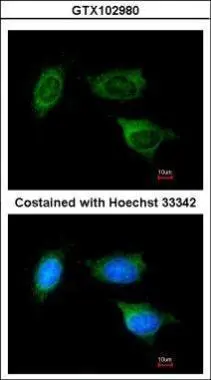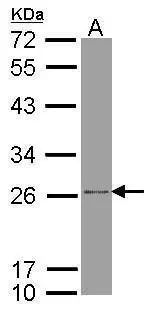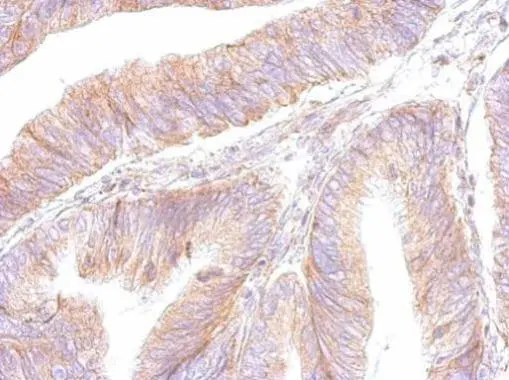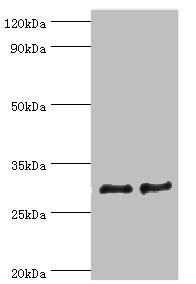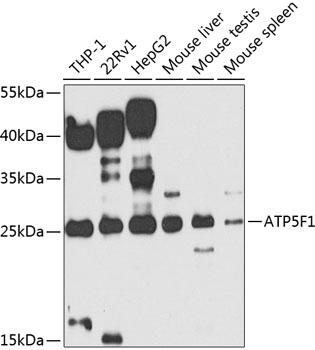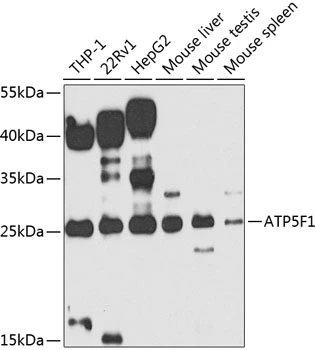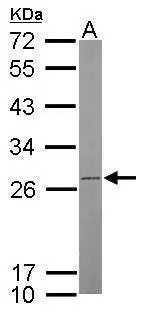
Sample (50 μg of whole cell lysate) A: mouse brain 12% SDS PAGE GTX102980 diluted at 1:500 The HRP-conjugated anti-rabbit IgG antibody (GTX213110-01) was used to detect the primary antibody.
ATP synthase B1 antibody
GTX102980
ApplicationsImmunoFluorescence, Western Blot, ImmunoCytoChemistry, ImmunoHistoChemistry, ImmunoHistoChemistry Paraffin
Product group Antibodies
ReactivityHuman, Mouse
TargetATP5PB
Overview
- SupplierGeneTex
- Product NameATP synthase B1 antibody
- Delivery Days Customer9
- Application Supplier NoteWB: 1:500-1:3000. ICC/IF: 1:100-1:1000. IHC-P: 1:100-1:1000. *Optimal dilutions/concentrations should be determined by the researcher.Not tested in other applications.
- ApplicationsImmunoFluorescence, Western Blot, ImmunoCytoChemistry, ImmunoHistoChemistry, ImmunoHistoChemistry Paraffin
- CertificationResearch Use Only
- ClonalityPolyclonal
- Concentration0.45 mg/ml
- ConjugateUnconjugated
- Gene ID515
- Target nameATP5PB
- Target descriptionATP synthase peripheral stalk-membrane subunit b
- Target synonymsATP5F1, PIG47, ATP synthase peripheral stalk subunit b, mitochondrial, ATP synthase B chain, mitochondrial, ATP synthase F(0) complex subunit B1, mitochondrial, ATP synthase proton-transporting mitochondrial F(0) complex subunit B1, ATP synthase subunit b, mitochondrial, ATP synthase, H+ transporting, mitochondrial F0 complex, subunit B1, ATP synthase, H+ transporting, mitochondrial F0 complex, subunit b, ATP synthase, H+ transporting, mitochondrial Fo complex subunit B1, ATPase subunit b, H+-ATP synthase subunit b, cell proliferation-inducing protein 47
- HostRabbit
- IsotypeIgG
- Protein IDP24539
- Protein NameATP synthase peripheral stalk subunit b, mitochondrial
- Scientific DescriptionThis gene encodes a subunit of mitochondrial ATP synthase. Mitochondrial ATP synthase catalyzes ATP synthesis, utilizing an electrochemical gradient of protons across the inner membrane during oxidative phosphorylation. ATP synthase is composed of two linked multi-subunit complexes: the soluble catalytic core, F1, and the membrane-spanning component, Fo, comprising the proton channel. The catalytic portion of mitochondrial ATP synthase consists of 5 different subunits (alpha, beta, gamma, delta, and epsilon) assembled with a stoichiometry of 3 alpha, 3 beta, and a single representative of the other 3. The proton channel seems to have nine subunits (a, b, c, d, e, f, g, F6 and 8). This gene encodes the b subunit of the proton channel. [provided by RefSeq]
- ReactivityHuman, Mouse
- Storage Instruction-20°C or -80°C,2°C to 8°C
- UNSPSC12352203

